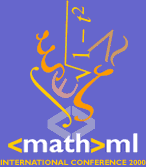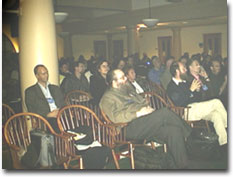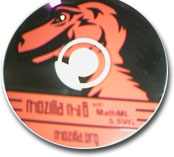Report on the International MathML and Math on the Web Conference 2000
04/Nov/2000
Report on the Conference
 The first International MathML conference hosted by Wolfram Research took place
October 20 to 21 in the Grainger Library on the campus of the University
of Illinois at Urbana-Champaign. The conference was sponsored by
Wolfram Research,
IBM,
AMS,
Compaq,
W3C,
Netscape,
Waterloo Maple, and
The University of Illinois'
Grainger Library.
The conference was
chaired by
Neil Soiffer (Wolfram Research),
Patrick Ion (AMS/Mathematical Reviews),
Angel Diaz (IBM T. J. Watson Center).
The first International MathML conference hosted by Wolfram Research took place
October 20 to 21 in the Grainger Library on the campus of the University
of Illinois at Urbana-Champaign. The conference was sponsored by
Wolfram Research,
IBM,
AMS,
Compaq,
W3C,
Netscape,
Waterloo Maple, and
The University of Illinois'
Grainger Library.
The conference was
chaired by
Neil Soiffer (Wolfram Research),
Patrick Ion (AMS/Mathematical Reviews),
Angel Diaz (IBM T. J. Watson Center).
 The conference attracted nearly 200 attendees, and this explains the loud applause
at the conference, as enjoyable presentations succeeded one after the other in
plenary sessions--the default format used at the conference. Much appreciation was
felt towards Wolfram Research Inc for their capable logistic which contributed
in making this conference a resounding success.
The conference attracted nearly 200 attendees, and this explains the loud applause
at the conference, as enjoyable presentations succeeded one after the other in
plenary sessions--the default format used at the conference. Much appreciation was
felt towards Wolfram Research Inc for their capable logistic which contributed
in making this conference a resounding success.
A pre-conference tutorial on the MathML specification was held on Thursday October 19 at Hawthorn Suites Hotel prior to the beginning of the conference the following day at the Grainger Library. One tutorial session was initially planned and was sold-out. Another one had to be undertaken in response to the high demand. Both sessions were conducted by the W3C MathML WG member Douglas Lovell of IBM T. J. Watson Center, New York.
IBM chose to announce the release of V3.0 version of its techexplorer hypermedia browser at the conference and participants were all invited on Friday at the IBM-sponsored celebration dinner! That day happened to be the birthday of Angel Diaz (IBM/Techexplorer) and Irene Vatton (W3C/Amaya), and they both managed to get the attendance to sing happy birthday for each of them.
The program of the conference initially consisted of an opening video address (by the Director of the W3C Tim Berners-Lee), two keynote addresses (the first by Robert Sutor of IBM and the second by Stephen Wolfram of Wofram Research Inc), eighteen talks, one panel session, two courseware, and several demonstrations and poster sessions. All these events were carried out as intended except that only seventeen talks and one courseware were finally undertaken, for two presenters found themselves unable to attend.
The themes covered at the conference were (in chronological order of presentation): MathML in Browsers, Computing with MathML, MathML and TeX, Validating MathML, Editing and Authoring MathML, Case Studies, and Representing Science. There were two or three talks under each theme, and it is planned that the slides of these talks will be made available on the conference website in the coming weeks. Although it is neither realistic nor the ambition of this report to detail the rich variety of subjects that were addressed in the talks, the reader might be interested in the surprising case study of the US patent office which is setting a trend that others might soon follow. The patent office is taking the emerging XML/XHTML/MathML seriously, as evidenced by the fact that it has adopted these formats for its database of patent submissions, with an average of 1,200 mathematical items (in MathML of course) archived each week.
 Courtesy of mozilla.org,
250 complimentary Mozilla CDs were specifically made for the conference (containing
M18 with
MathML & SVG and the
brownbag
training videos). With the prospect of riding the lizard
just a few clicks away, the batch of CDs disappeared like hot cakes
from the conference desk.
Those who successfully jumped the two initiatory hurdles
(fonts and the
"riddle" of the .xml extension) were rumored to have enjoyed
their experience. So much so that one independent presenter even opted
for a live demo of his MathML with his brand new copy of Mozilla (a
Work In Progress (WIP) with risks, remember). And when the splash
screen appeared on the projector with the magnified firing lizard,
the attendance cheered spontaneously.
Speaking of fonts, the exciting news to share is that
Wolfram Research and
Design Science
have finally agreed to relax their licensing restrictions
for Mozilla, and this means that bundling and auto-installing crucial
MathML fonts can become an item in the design and implementation of
the Mozilla MathML component.
Courtesy of mozilla.org,
250 complimentary Mozilla CDs were specifically made for the conference (containing
M18 with
MathML & SVG and the
brownbag
training videos). With the prospect of riding the lizard
just a few clicks away, the batch of CDs disappeared like hot cakes
from the conference desk.
Those who successfully jumped the two initiatory hurdles
(fonts and the
"riddle" of the .xml extension) were rumored to have enjoyed
their experience. So much so that one independent presenter even opted
for a live demo of his MathML with his brand new copy of Mozilla (a
Work In Progress (WIP) with risks, remember). And when the splash
screen appeared on the projector with the magnified firing lizard,
the attendance cheered spontaneously.
Speaking of fonts, the exciting news to share is that
Wolfram Research and
Design Science
have finally agreed to relax their licensing restrictions
for Mozilla, and this means that bundling and auto-installing crucial
MathML fonts can become an item in the design and implementation of
the Mozilla MathML component.
Echo from Champaign...
Since it is intended that MathML snippets will be sprinkled throughout larger documents (such as XHTML) which are typically aimed at browsers, it was therefore no surprise that conference attendees were eager to know how the implementation of MathML is coming along inside the major browsers. Consequently, the theme "MathML in Browsers" was a hot topic at the conference, and probably making the topic even hotter was the fact that the two talks under this theme were MathML in Internet Explorer and MathML in Mozilla. So what is going on then, you might also ask, and what about the browser-editor Amaya. Below is a perspective on the story.It is good to first put things in context. IE may be a closed-source that sometimes curiously take a seemingly long time to resolve the DNS than to fetch a web page, but since their rewrite in version 4 and their foundation laid there, the IE team has implemented a few things that are just starting to happen in Mozilla, and their layout engine has collected a consistent number of positive reviews. Therefore the question really was: can that layout engine stand the torture of MathML? The approach used in IE doesn't allow to answer the question, however. Indeed MathML hasn't been made a built-in part of IE and the rendering presented at the conference relied on Design Science's MathPlayer plug-in. The MathPlayer is a COM object specifically tuned for IE. It interacts through IE's layout APIs, and enough APIs were extended by the IE team to allow proper spacing and baseline alignments--these are the critical features that were lacking in earlier generations of plug-ins. As a result of these join-forces, the rendering at defaut font-size looks quite good. While this approach shows a great degree of extensibility of the layout engine, and may have some merits especially for non-textual XML applications, the approach suffers from some limitations that are not present in the Mozilla approach--as far as MathML rendering is concerned. Also, because a plug-in is a plug-in (at least in this generation), the users has to resort to the <object> tag, which precludes fine-grain operations down to leaf nodes within the math container.
It should be recalled that some of the strengths of the Mozilla approach are: a cross-platform rendering with an input in standards XHTML+MathML with namespace support, the ability to style the MathML with standards CSS, the ability to interact with the MathML, e.g., searching for the 'cos' function in formulas by just doing Edit -> Find [cos], re-sizing the entire document along with formulas by just visiting View -> TextSize (this last feature proved particularly useful to zoom the Mozilla presentation on the projector). Of course, Mozilla has its share of weaknesses which are not necessary to repeat here. Remember to use bugzilla to investigate any problems that you might encounter. Maybe by the time these are fixed, the IE team would have fixed theirs, enabling scientists and web-authors to expect that their standards compliant MathML will "just work" in their favorite browser, whichever it is, hopefully Mozilla...
While many see Amaya as an underdog amongst browsers, it is generally said to shine on its editing capabilities. In particular, its standards compliant XTHML+MathML output should in principle be suitable for rendering in Mozilla. The version demonstrated at the conference included editing of MathML as well as some WIP on editing SVG. It was impressive to see live editing of mixed MathML and SVG through the so-called "structure view" (or the DOMviewer in Mozilla's terminology). Changes in the structure view were reflected in the content window in real-time and vice-versa. Evaluating this mode when attacking the editing aspect of the Mozilla MathML project might provide some insights into this much needed aspect on mainstream browsers.